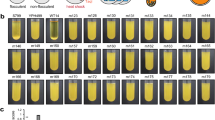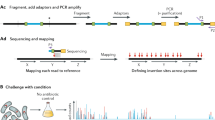Abstract
With the accumulation of large-scale sequence data, emphasis in genomics has shifted from determining gene structure to testing gene function, and this relies on reverse genetic methodology. Here we explore the feasibility of screening for chemically induced mutations in target sequences in Arabidopsis thaliana. Our TILLING (Targeting Induced Local Lesions IN Genomes) method combines the efficiency of ethyl methanesulfonate (EMS)-induced mutagenesis1 with the ability of denaturing high-performance liquid chromatography (DHPLC) to detect base pair changes by heteroduplex analysis2. Importantly, this method generates a wide range of mutant alleles, is fast and automatable, and is applicable to any organism that can be chemically mutagenized.
This is a preview of subscription content, access via your institution
Access options
Subscribe to this journal
Receive 12 print issues and online access
$209.00 per year
only $17.42 per issue
Buy this article
- Purchase on Springer Link
- Instant access to full article PDF
Prices may be subject to local taxes which are calculated during checkout

Similar content being viewed by others
References
Koornneef, M., Dellaert, L.W. & van der Veen, J.H. EMS- and radiation-induced mutation frequencies at individual loci in Arabidopsis thaliana (L.) Heynh. Mutat. Res. 93, 109–123 (1982).
Underhill, P.A. et al. Detection of numerous Y chromosome biallelic polymorphisms by denaturing high-performance liquid chromatography. Genome Res. 7, 996–1005 (1997).
Henikoff, S. & Comai, L.A. DNA methyltransferase homolog with a chromodomain exists in multiple forms in Arabidopsis. Genetics 149, 307–318 (1998).
Platero, J.S., Hartnett, T. & Eissenberg, J.C. Functional analysis of the chromo domain of HP1. EMBO J. 14, 3977–3986 (1995).
Rose, T.M. et al. Consensus-degenerate hybrid oligonucleotide primers for amplification of distantly related sequences. Nucleic Acids Res. 26, 1628–1635 (1998).
http://aims.cps.msu.edu/aims/ AIMS: Arabidopsis Information Management System.
Gross, E. et al. A comparison of BRCA1 mutation analysis by direct sequencing, SSCP and DHPLC. Hum. Genet. 105, 72–78 (1999).
Li-Sucholeiki, X.C. et al. Applications of constant denaturant capillary electrophoresis/high-fidelity polymerase chain reaction to human genetic analysis. Electrophoresis 20, 1224–1232 (1999).
Posfai, J. et al. Predictive motifs derived from cytosine methyltransferases. Nucleic Acids Res. 17, 2421–2435 (1989).
Liu, L.X. et al. High-throughput isolation of Caenorhabditis elegans deletion mutants. Genome Res. 9, 859–867 (1999).
Bowman, J.L., Smyth, D.R. & Meyerowitz, E.M. Genes directing flower development in Arabidopsis. Plant Cell 1, 37–52 (1989).
Schimenti, J. & Bucan, M. Functional genomics in the mouse: phenotype-based mutagenesis screens. Genome Res. 8, 698–710 (1998).
Kheterpal, I. & Mathies, R.A. Capillary array electrophoresis DNA sequencing. Anal. Chem. 71, 31A–37A (1999).
Larsen, L.A. et al. High-throughput single-strand conformation polymorphism analysis by automated capillary electrophoresis: robust multiplex analysis and pattern-based identification of allelic variants. Hum. Mutat. 13, 318–327 (1999).
Oleykowski, C.A. et al. Mutation detection using a novel plant endonuclease. Nucleic Acids Res. 26, 4597–4602 (1998).
Aljanabi, S.M. & Martinez, I. Universal and rapid salt-extraction of high quality genomic DNA for PCR-based techniques. Nucleic Acids Res. 25, 4692 (1997).
Kuklin, A. et al. Detection of single-nucleotide polymorphisms with the WAVE DNA fragment analysis system. Genetic Testing 1, 201–206 (1997).
Jones, A.C. et al. Optimal temperature selection for mutation detection by denaturing HPLC and comparison to single-stranded conformation polymorphism and heteroduplex analysis. Clin. Chem. 45, 1133–1140 (1999).
Acknowledgements
We thank Bruce Draper for helpful discussions. This work was supported by grant RO1 GM29009 (to S.H.) from the National Institutes of Health. S.H. is an investigator of the Howard Hughes Medical Foundation, which also provided support for Karen Wolfe of the James Roberts lab, whom we thank for helping us with the screen.
Author information
Authors and Affiliations
Corresponding author
Rights and permissions
About this article
Cite this article
McCallum, C., Comai, L., Greene, E. et al. Targeted screening for induced mutations. Nat Biotechnol 18, 455–457 (2000). https://doi.org/10.1038/74542
Received:
Accepted:
Issue Date:
DOI: https://doi.org/10.1038/74542



